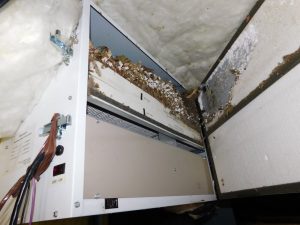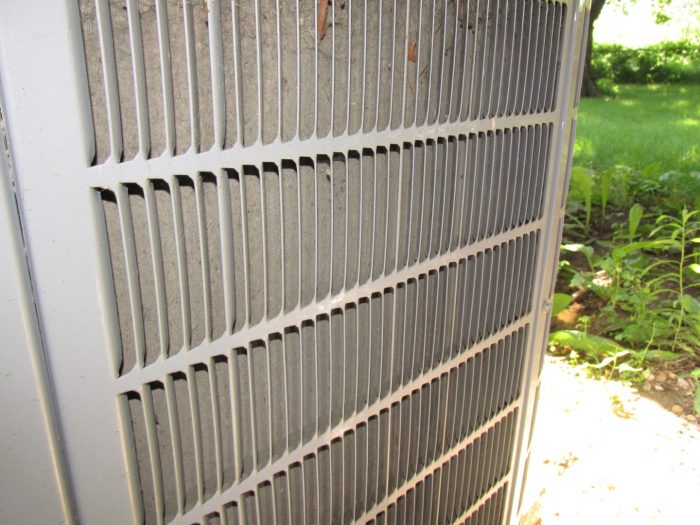Summer is officially here, and the warm weather we had last weekend gave homeowners with air conditioners a chance to make sure their systems were still operating properly. Not only did I inspect a house on Friday with a completely iced up air conditioner, but I heard from numerous friends about air conditioners that weren’t working properly. If your air conditioner isn’t cooling your home the way you expect it to, check on these simple maintenance items before calling out a professional to service your equipment.
Oh, and even if your system is working properly, check these things regular. This is important stuff.
The Air Filter
 The single most important thing for homeowners to maintain is the air filter, and by “maintain” I mean “change religiously”. On most Minnesota homes, the air filter is also known as the furnace filter. If it’s one of those super-cheap single-ply 1″ filters, it should be changed at least once per month. Even better yet would be to use a better filter. According to Bruce Strandberg at BWS Heating & Air, cheap filters let a lot of small particulates through. These small particulates can accumulate on the underside of the evaporator coil, and even on the underside of secondary heat exchangers in high-efficiency furnaces, where they restrict airflow, reducing system efficiency.
The single most important thing for homeowners to maintain is the air filter, and by “maintain” I mean “change religiously”. On most Minnesota homes, the air filter is also known as the furnace filter. If it’s one of those super-cheap single-ply 1″ filters, it should be changed at least once per month. Even better yet would be to use a better filter. According to Bruce Strandberg at BWS Heating & Air, cheap filters let a lot of small particulates through. These small particulates can accumulate on the underside of the evaporator coil, and even on the underside of secondary heat exchangers in high-efficiency furnaces, where they restrict airflow, reducing system efficiency.
Mid-grade pleated 1″ filters have more surface area, so don’t need to be changed as frequently, but most heating contractors still recommend changing them monthly. That’s not bad advice, but it’s probably more often than needed. These pleated filters are designed to be changed at least once every 90 days. My advice is to buy a big box of them, keep them by your furnace, and set a calendar alert every 60 – 90 days reminding you to change your filter. If your filter is nasty when you change it, do it more often.
High-grade super-duper ultra-filtration-smation filters are fine to use if they’re changed religiously, but they’re not as forgiving as other filters, meaning they get clogged more quickly, which causes problems with equipment much faster. Use these filters at your own risk.
For filters thicker than 1″, take the filter manufacturer’s recommendation for changing and cut the number in half to be safe. It might cost a little more in filters, but this is nothing compared to repair costs.
The Condensing Coil
This is the one that really gets forgotten about. The compressor and condensing coil are the parts that sit outside the home, preferably on the side of your yard where the noise isn’t too obnoxious. To help dissipate the heat that gets removed from the home, a big fan pulls outdoor air over the condensing coils.
For the condensing coil to work properly, it needs plenty of airflow. The condensing coil should not be obstructed by other nearby units, house walls, plants, weeds, flowers, decorative shrouds, decks, etc. All of these things will hamper airflow.
Condensing coils also need to be cleaned regularly. When they operate, the fans suck air in on all of the open sides. This tends to pull in debris such as dirt, grass clippings, dryer lint, cottonwood seeds, and everything else in the air… except for love. Inspect all sides of your outdoor unit and clean the coils off annually, or as needed.
If your air conditioner still isn’t working properly after checking these things, check out my blog post from last year, How to Inspect Your Own House, Part 9: The Air Conditioner. This post gets a little bit more detailed and involves some troubleshooting steps that homeowners can try.
If you notice ice on your unit either inside the house or outside and you’ve already checked everything listed in the post linked to above, it’s time to call in a professional. Just be sure to contact someone you know and trust. If you don’t have someone, get a referral from a friend or neighbor. If you don’t have that, check reviews online before hiring. Also, beware of cheap AC tune-ups.
Author: Reuben Saltzman, Structure Tech Home Inspections


Wayne Johnson
June 21, 2016, 5:11 am
By thicker than 1″, did you mean wider? Manufacturers now recommend wider filters like 4″ for better air flow. More surface space is more forgiving than 1″. We install 4″ filters with all new Variable Speed furnaces if there isn’t a space limitation.
I was part of 3M round table about filters and they showed how better air flow occurred with a 4″ media filter over a 1″ due to more surface space. The material was the same but was not so dense.
Reuben Saltzman
June 21, 2016, 5:16 am
@Wayne – exactly.
Matt
June 21, 2016, 10:35 am
I’ve been a big follower of your blog for a long time. This particular subject is one where I’ve gotten a lot of conflicting information. Two different furnace / HVAC companies have told me to only run foam dust-protector type filters (‘The cheapest you can find’) in the summer time to allow for more airflow over the coils. I used to run the 3M allergen filter $20 filters all the time to improve overall air quality in the house but they told me that these make the motor work harder using more electricity, one even took the time to show me the difference in amps pulled between two brand new filters of the two types. A slightly better filter for winter I was told is okay but summer time it should be the cheapo’s to let the maximum amount of air flow through the system as possible. What do you think of this advice?
Reuben Saltzman
June 21, 2016, 1:00 pm
Hi Matt,
I’m not a fan of the 3M allergen filters; I think they get clogged too easily. You really want to have maximum airflow during both the summer and winter, but you also don’t your system getting clogged up. I think it’s smartest to use a filter that will allow for maximum airflow without clogging your system. I may have to do a follow-up blog post on this topic.
As for a dirty filter causing your system to draw *more* amps, I just read a blog post from a friend of mine that explained the exact opposite. Check it out: http://www.buellinspections.com/when-things-just-go-round-and-round-and-round/
D
June 21, 2016, 4:43 pm
Hi Reuben,
Is it OK to hose down the outside unit? I saw a repairman do that once. Is that what you had in mind as a method to clean the coils?
Reuben Saltzman
June 21, 2016, 4:52 pm
@D – exactly. Spray it down with a garden hose. Don’t use a pressure washer.
Victor Migneco
July 8, 2016, 10:50 am
What about a coil install without a pad, in an are that floods due to clogged area drains. I cam across that yesterday in an inspection. Combined with the fact that coil was made in 1988, I recommended in the report that an HVAC contractor take a look.
Reuben Saltzman
July 8, 2016, 11:15 am
@Victor – I’d say that would fall outside of “regular maintenance”, but certainly something worth bringing up during a home inspection.
Erika
August 14, 2016, 9:56 pm
Great information here. My a/c is 15 yrs old and my energy bill is killing us. I’m sure replacement time is near.